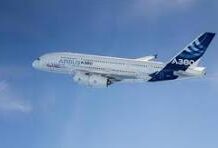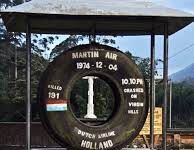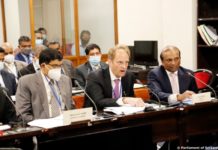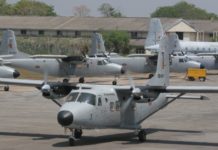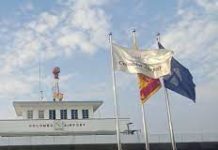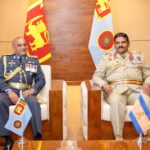By: Roger Thiedeman
This article is adapted from the original published in the Sri Lanka Sunday Times on November 23, 1997 (http://www.sundaytimes.lk/971123/plus10.html) under the title shown above. The title initially submitted, ‘Reminiscing at Ratmalana’, was changed at the whim of an anonymous Sunday Times sub-editor.
In August this year I stood outside the Ratmalana airbase and watched a Sri Lanka Air Force Antonov An-32B take off. As the transport aircraft soared aloft in a climbing turn towards the north, my memories and imagination also took flight.
I thought back to more peaceful times when Ratmalana was just a civil aerodrome, and the many happy hours I spent there as a boy and young adult. A smile creased my face when I remembered the first time I flew in an aeroplane. A Christmas present from my parents in 1962, that nocturnal joy flight from Ratmalana in an Air Ceylon Douglas DC-3, 4R-ACI, piloted by Captain Harry Hatharasinghe remains one of my happiest memories. Also happy to relate, that selfsame Dakota (pictured below during its Air Ceylon prime), which was subsequently taken over by the Sri Lanka Air Force, remains at Ratmalana on static display at the SLAF Museum.
Then there was an equally pleasant jaunt one Sunday (or Poya day holiday) morning in 1970 aboard a vintage de Havilland D.H.89B Dragon Rapide wood-and-fabric, twin-engine biplane, 4R-AAI, flown by Capt. Nihal Jayawickrema. Joining me in the air that day were my sister Rosanne and girlfriend Ingrid (who later became my wife).
Another Ratmalana memory was the time Dad took me to see the aftermath of the crash of Indian Airlines Vickers Viscount VT-DIH in November 1961. Landing in pelting rain, the plane slid off the runway and across Airport Road, demolishing fences as it went. The Viscount ended up on its belly, on the manicured lawns and flower beds of the Bata Shoe Company, never to fly again. Fortunately, there were no fatalities or serious injuries, only one passenger suffering a mild heart attack.
Gazing at the receding smoke trails of the An-32, now merely a speck in the sky, other memories of Ratmalana came flooding back. For example, Friday, October 30, 1964, the day when Air Ceylon received its first, very own jet-prop aircraft: Hawker Siddeley (Avro) 748, 4R-ACJ. I still recall, vividly, the festive atmosphere as the Avro touched down at Ratmalana at the end of its delivery flight from Manchester, with Captains P.B. Mawalagedera and George Ferdinand in charge.
Fourteen years elapsed before I got the opportunity to travel on board that Avro. Less than three weeks after I flew in it to Jaffna, and back the next day, I heard the sad news that the aircraft was destroyed by a bomb while parked at Ratmalana on September 7, 1978. Again, miraculously, no lives were lost.
How could I forget an air display staged by the Ratmalana Flying Training School in 1967? Several memorable highlights capped off the day. The first, a masterful exhibition in de Havilland D.H.82 Tiger Moth 4R-AAB by Captain Dudley Ranabahu, who still serves as Upali Aviation’s Chief Flying Instructor at Ratmalana. His breathtaking routine of stunts and aerobatics, choreographed into a comedy act belying the skill involved, was titled රනබාහුගේ නාකි කොටියා (Ranabahuge Naaki Kotiya; ‘Ranabahu’s Old Tiger’) – much to everyone’s delight.
Also entertaining the huge crowd with a thrilling display was Nihal Ratnayake in another flying school aircraft, de Havilland DHC-1 Chipmunk 4R-ACM.
Yet another highlight of the air show was a Bristol Britannia 312 of British Eagle Airlines, en route from Katunayake to Singapore, that was requested to make a slight detour for the benefit of spectators at Ratmalana. The large, four-engine turboprop whistled overhead in near-silence, just a few hundred feet above the runway, making it easy to understand why BOAC used to call their Britannias ‘Whispering Giants’.
Although not present at Ratmalana when it happened, I remembered the night of February 24, 1964 when a carrier-based Breguet Alizé anti-submarine warfare aircraft of the Indian Navy landed at Ratmalana without permission, triggering an international incident. I did, however, hear and see the Alizé fly low over our home in Wellawatte just a few minutes before it touched down. The aircraft was totally unlit, having lost all its electrical power. With inoperative radio and navigational equipment, the pilot could not find his way back to the aircraft carrier, so he decided to make for the safety of Ratmalana instead.
My memories of Ratmalana all but exhausted, my imagination now took over. I tried to visualise the ‘glory days’ of Ratmalana, when it was Ceylon’s international airport. The days of the 1950s and early 1960s, when Douglas DC-4 Skymasters, Lockheed Constellations and Starliners, Viscounts, de Havilland D.H.106 Comets and Lockheed L-188 Electras brought passengers from, and took them to, far corners of the globe.
In my mind’s eye I saw another time when, like today, Ratmalana was given over to less peaceful pursuits. My mental calendar rewound to Easter Sunday, April 5, 1942, imagining Hawker Hurricanes and Fairey Fulmars of the Royal Air Force scrambling from Ratmalana (WW2-period ‘overview’ pics below) to intercept and repulse Japanese warplanes coming to drop their lethal loads over Ceylon.
Yet another image swam into view. The date was November 13, 1946. A large crowd had thronged Ratmalana to greet a young Cambridge graduate named J.P. Obeyesekere. He was expected at any moment in his Auster J/1 Autocrat, VP-CAO, having left England at the start of a marathon journey home more than a month before. Mere minutes after Obeyesekere landed he was followed down by an Englishman named R.A.F. Farquharson, who had closely accompanied the Ceylonese flyer all the way in an identical Auster, VP-CAP.
I mentally pictured the 10th day of December 1947, a Wednesday, when Air Ceylon DC-3 VP-CAR, Sita Devi, with Captain Peter Fernando in command, operated the airline’s inaugural revenue flight from Ratmalana to Kankesanturai (Jaffna) and Madras. This year marks the 50th anniversary of the birth of Air Ceylon, the airline that never recorded a single passenger fatality throughout its 32 years of existence.
The SLAF Antonov had disappeared into the distance. Dusk began to cast its mantle over Ratmalana on that August evening. My imagination conjured up one last scene. November 27, 1935, nearly 62 years ago today, when Mr. H. Tyndale-Biscoe, Chief Instructor of the Madras Flying Club, piloted the first aeroplane to land at Ratmalana. Accompanying him from Madras in the 3-seater de Havilland D.H.80A Puss Moth, registered VT-ACB in India, were Mr. W.B. Schleiter and Mr. C.B. Darius, a Ceylonese.
That night, back in bed at Borella, I slept soundly. Peace had returned to Sri Lanka. Ratmalana was once again a civil airport. Gone were the security barriers, gun emplacements, watch towers and other trappings of a wartime military airfield. Then I woke up and realised with a sigh … yes, it was only a dream.
Picture Sources and Credits
Page 1:
top: © John Stroud (author’s collection)
bottom: © Rogier Westerhuis via Airliners.net
Page 2:
both pics: Capt. Dhamseth Pallawela collection
Page 3:
top: author’s collection
bottom: Google Images
Page 4:
top: Capt. Dhamseth Pallawela collection
bottom: author’s collection, via Lake House Group archives
Page 5:
both pics: Capt. Nimal Rambukwelle collection
Page 6:
top: Google Images
bottom: author’s collection © Bharat-Rakshak.com
Page 7:
top: author’s collection, via Lake House Group archives
bottom: author’s collection; Air Ceylon Review, October 1959
Page 8:
both pics: Google Images
Page 9:
left: author’s collection, via Lake House Group archives
right: photo by author
Page 10:
author’s collection, via Lake House Group archives
Page 11:
author’s collection, via Lake House Group archives
Page 12:
author’s collection, via Lake House Group archives
NB: The author also extends sincere thanks to Capt. Gihan A. (‘GAF’) Fernando for assistance with information and fact-checking.
KWK_29-9-21




